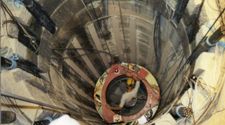
The THERESA project was an international co-operative research project sponsored by the European Commission undertaken between 2007 and 2009. With support from the Swedish nuclear power regulator SSM, Quintessa contributed to the modelling of coupled thermo, hydro and mechanical (THM) processes in the bentonite buffer that is used in several designs for deep radioactive waste repositories using software based on Quintessa's QPAC general-purpose modelling code.
Bentonite is a complex material and modelling its behaviour is a challenging problem. Good comparisons were obtained between QPAC-EBS calculations and experimental data for the evolution of temperature, saturation, density, relative humidity, stresses and pressures. Process model developments were at the heart of the QPAC-EBS contribution, and latterly included a more sophisticated, complete and internally consistent representation bentonite for comparison with the 'typical' THM approach. This new process model explicitly considers the disposition and physical form of water in the bentonite-water-air system, and uses this micro-scale knowledge to model macro-scale emergent phenomena such as swelling and porosity structure changes. The main advantage of this process model is that is uses a smaller set of free parameters than previously required and also gives information on bentonite structure relevant for coupled reactive species transport calculations, hence may be more suitable for fully coupled THMC calculations in bentonite than more traditional approaches.
This project provides a good example of how complex non-linear systems and novel process systems can be modelled effectively using QPAC technology.